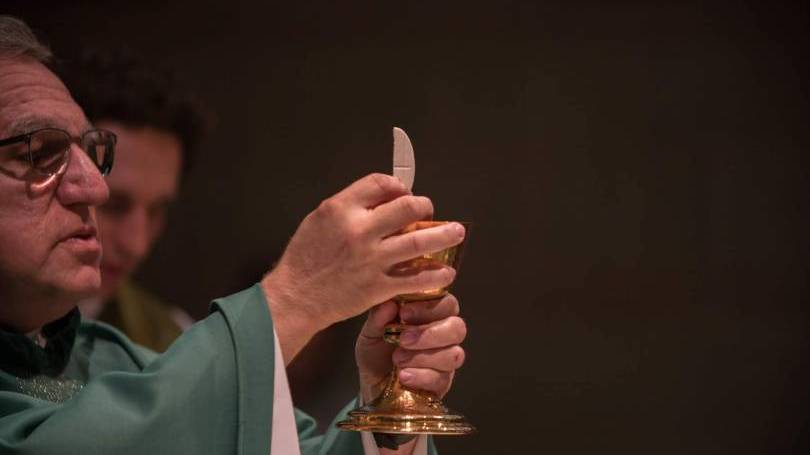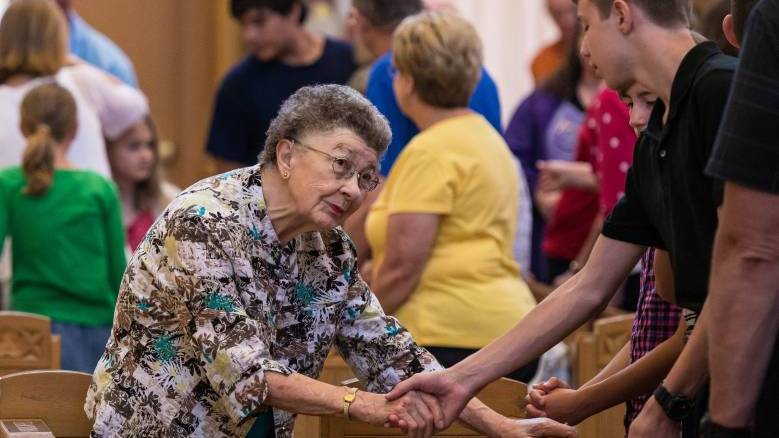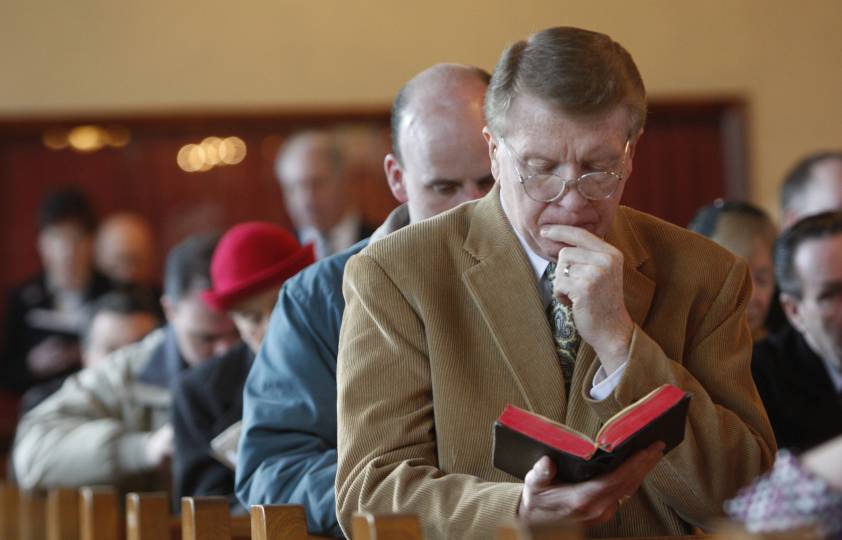I hope that so far this series is proving useful to you and that you are participating more
actively, deeply, and consciously in the Mass. So far, we’ve looked at most of the Mass. We started with the
Entrance, the
Penitential Rite and the Gloria. Then, in the
Liturgy of the Word we looked at the
Readings, the
homily, the Creed, and the Prayers of the Faithful, the
Liturgy of the Eucharist, and the
Eucharistic Prayer.
Last week we returned to the
Eucharistic Prayer because there's a lot to say about that beautiful part of the Mass.
The Eucharistic Prayer ends with the
Doxology and the
Great Amen. In most dioceses in North America, that’s when everyone stands up after kneeling.
We then enter the
Communion Rite.
At the heart and the reality of the word “communion” is “union.” Our Eucharist leads to union. Our personal union with Christ at the time of
Communion is pivotal. But the goal is not just union with Christ, but union in Christ. The Communion Rite is about shared life. It is about sharing life with God, the Father, Son and Holy Spirit, and with each other in Christ and through Christ. It is also about a unity that is made possible and brought about by the Holy Spirit.
The Lord’s Prayer
This is why the first thing that we do in the Communion Rite is say the Lord’s Prayer. The Church wasn’t just inspired to place it in the Communion Rite because of its reference to daily bread. Our unity in and through Christ is highlighted by the use of the collective word “we” throughout this prayer. The phrase,
“Thy kingdom come,” recalls Jesus’ words,
“I will never drink of this fruit of the vine until the day when I drink it new with you in my Father’s kingdom” (Matthew 26:29). When we ask to be forgiven as we forgive others, it expresses our desire to enter into true communion with Christ and with each other. The prayer is very much a prayer that calls us to the unity that takes place in a very physical way during Communion.
If you’ve ever been to a Protestant or Anglican service, you may have heard that they insert the following after the Lord’s Prayer:
“For the kingdom, the power and the glory are yours, now and forever.” This is called the doxology.
In the Mass, we include the doxology, but before it, the Priest inserts a brief invocation which develops that last petition of the Lord’s Prayer for deliverance from evil: He pleads for peace, for freedom from sin, and for safety from distress before returning to a proclamation of joyous hope in Christ’s return.
The Rite of Peace
Some people may wonder why the sign of peace takes place at this time. I have even wondered this. If you think of it, the sign of peace is our clearest expression of our readiness for sharing in communion. This action is a pledge and a prayer for unity for the Church and for the whole human family. In other countries, this moment is a movement in itself, with its own song. In North America, the sign of peace is usually given as a handshake or bow.
CNS photo/Sam Lucero, The Compass
After the Priest announces and offers the sign of peace, it is the deacon, if there is one, who invites everyone to offer each other the sign of peace.
The
General Instruction of the Roman Missal states that the presider may exchange the sign of peace with the ministers, but (except in certain special occasions, such as a Wedding) should remain in the Sanctuary so as not to disrupt the celebration (
GIRM 154).
The Fraction of the Bread
After the Sign of Peace, the Priest breaks the bread. This gesture of breaking bread was done by Christ at the Last Supper and gave the entire celebration its name in apostolic times: Breaking of Bread (see Acts 2:42-46).
The
General Instruction says that the bread used in the liturgy is required to truly have the appearance of food (
GIRM 321). Therefore the Eucharistic bread is made in such a way that the Priest is truly able to break it into parts and distribute these to at least some of the faithful. This gesture of breaking of bread brings out more clearly the importance of the sign of the unity of all in the one bread (see 1 Corinthians 10:16), and of the sign of charity by the fact that the one bread is distributed among all.
After he breaks the bread, the Priest puts a piece into the chalice. He says quietly,
“May this mingling of the Body and Blood of our Lord Jesus Christ bring eternal life to us who receive it.” This signifies the unity of the Body and Blood of the Lord in the work of salvation.
Agnus Dei (Lamb of God)
The sole purpose of the
Agnus Dei litany is to accompany the breaking of the bread and is usually sung. It should not begin until the breaking begins and need not end until all the bread has been broken and the patens have been prepared. At a regular Sunday Mass this doesn’t take a long time; however, I’ve been at massive celebrations, either at Conferences or special occasions when we have dozens of
ciboria (the receptacle shaped like a cup with a lid that is used for the distribution and reservation of the Eucharist) that have to be prepared.
After the Fraction, it is the norm in most dioceses in Canada that everyone kneels once more.
CNS photo/Gregory A. Shemitz
The Priest then, with hands joined, says quietly:
“Lord Jesus Christ, Son of the living God,
who, by the will of the Father
and the work of the Holy Spirit,
through your Death gave life to the world,
free me by this, your most holy Body and Blood,
from all my sins and from every evil;
keep me always faithful to your commandments,
and never let me be parted from you.”
Or:
“May the receiving of your Body and Blood,
Lord Jesus Christ,
not bring me to judgement and condemnation,
but through your loving mercy
be for me protection in mind and body
and a healing remedy.”
The Priest then genuflects, takes the host, and, holding it slightly raised above the paten or above the chalice, while facing the people, says aloud:
“Behold the Lamb of God, behold him who takes away the sins of the world. Blessed are those called to the supper of the Lamb.”
And together with the people he adds once:
“Lord, I am not worthy that you should enter under my roof,
but only say the word and my soul shall be healed.” (see Matthew 8:8)
The Priest, before consuming the Body of Christ, then says quietly:
“May the Body of Christ keep me safe for eternal life.”
Then he takes the chalice and says quietly:
“May the Blood of Christ keep me safe for eternal life.”
And he reverently consumes the Blood of Christ.
He then proceeds to distribute Communion to the Congregation.
Come back next week and we will continue with the Communion Rite.
[Most of the information used in these blog posts, comes from the text of a video made by Salt + Light Television in partnership with the National Liturgy Office of the Canadian Conference of Catholic Bishops in 2011, to help explain the latest changes to the language of the English Roman Missal, titled, THE CELEBRATION OF EUCHARIST for the Twenty-First Century. The project was headed by Fr. Bill Burke and text of that video was written by Canadian liturgist Margaret Bick, both of whom I owe a great deal of thanks for the vast knowledge they shared with us.]

Every week, Deacon Pedro takes a particular topic apart, not so much to explore or explain the subject to its fullness, but rather to provide insights that will deepen our understanding of the subject. And don’t worry, at the end of the day he always puts the pieces back together. There are no limits to deaconstructing: Write to him and ask any questions about the faith or Church teaching:
[email protected]



 Every week, Deacon Pedro takes a particular topic apart, not so much to explore or explain the subject to its fullness, but rather to provide insights that will deepen our understanding of the subject. And don’t worry, at the end of the day he always puts the pieces back together. There are no limits to deaconstructing: Write to him and ask any questions about the faith or Church teaching: [email protected]
Every week, Deacon Pedro takes a particular topic apart, not so much to explore or explain the subject to its fullness, but rather to provide insights that will deepen our understanding of the subject. And don’t worry, at the end of the day he always puts the pieces back together. There are no limits to deaconstructing: Write to him and ask any questions about the faith or Church teaching: [email protected]